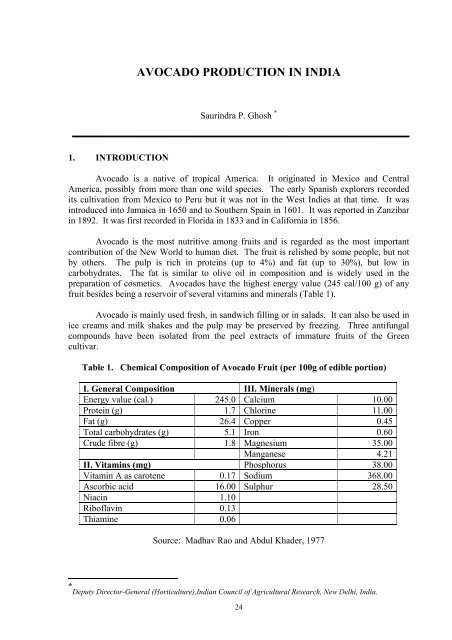Avocado Production in Asia and the Pacific - United Nations in ...
Avocado Production in Asia and the Pacific - United Nations in ...
Avocado Production in Asia and the Pacific - United Nations in ...
You also want an ePaper? Increase the reach of your titles
YUMPU automatically turns print PDFs into web optimized ePapers that Google loves.
AVOCADO PRODUCTION IN INDIA<br />
Saur<strong>in</strong>dra P. Ghosh *<br />
1. INTRODUCTION<br />
<strong>Avocado</strong> is a native of tropical America. It orig<strong>in</strong>ated <strong>in</strong> Mexico <strong>and</strong> Central<br />
America, possibly from more than one wild species. The early Spanish explorers recorded<br />
its cultivation from Mexico to Peru but it was not <strong>in</strong> <strong>the</strong> West Indies at that time. It was<br />
<strong>in</strong>troduced <strong>in</strong>to Jamaica <strong>in</strong> 1650 <strong>and</strong> to Sou<strong>the</strong>rn Spa<strong>in</strong> <strong>in</strong> 1601. It was reported <strong>in</strong> Zanzibar<br />
<strong>in</strong> 1892. It was first recorded <strong>in</strong> Florida <strong>in</strong> 1833 <strong>and</strong> <strong>in</strong> California <strong>in</strong> 1856.<br />
<strong>Avocado</strong> is <strong>the</strong> most nutritive among fruits <strong>and</strong> is regarded as <strong>the</strong> most important<br />
contribution of <strong>the</strong> New World to human diet. The fruit is relished by some people, but not<br />
by o<strong>the</strong>rs. The pulp is rich <strong>in</strong> prote<strong>in</strong>s (up to 4%) <strong>and</strong> fat (up to 30%), but low <strong>in</strong><br />
carbohydrates. The fat is similar to olive oil <strong>in</strong> composition <strong>and</strong> is widely used <strong>in</strong> <strong>the</strong><br />
preparation of cosmetics. <strong>Avocado</strong>s have <strong>the</strong> highest energy value (245 cal/100 g) of any<br />
fruit besides be<strong>in</strong>g a reservoir of several vitam<strong>in</strong>s <strong>and</strong> m<strong>in</strong>erals (Table 1).<br />
<strong>Avocado</strong> is ma<strong>in</strong>ly used fresh, <strong>in</strong> s<strong>and</strong>wich fill<strong>in</strong>g or <strong>in</strong> salads. It can also be used <strong>in</strong><br />
ice creams <strong>and</strong> milk shakes <strong>and</strong> <strong>the</strong> pulp may be preserved by freez<strong>in</strong>g. Three antifungal<br />
compounds have been isolated from <strong>the</strong> peel extracts of immature fruits of <strong>the</strong> Green<br />
cultivar.<br />
Table 1. Chemical Composition of <strong>Avocado</strong> Fruit (per 100g of edible portion)<br />
I. General Composition III. M<strong>in</strong>erals (mg)<br />
Energy value (cal.) 245.0 Calcium 10.00<br />
Prote<strong>in</strong> (g) 1.7 Chlor<strong>in</strong>e 11.00<br />
Fat (g) 26.4 Copper 0.45<br />
Total carbohydrates (g) 5.1 Iron 0.60<br />
Crude fibre (g) 1.8 Magnesium 35.00<br />
Manganese 4.21<br />
II. Vitam<strong>in</strong>s (mg) Phosphorus 38.00<br />
Vitam<strong>in</strong> A as carotene 0.17 Sodium 368.00<br />
Ascorbic acid 16.00 Sulphur 28.50<br />
Niac<strong>in</strong> 1.10<br />
Riboflav<strong>in</strong> 0.13<br />
Thiam<strong>in</strong>e 0.06<br />
Source: Madhav Rao <strong>and</strong> Abdul Khader, 1977<br />
* Deputy Director-General (Horticulture),Indian Council of Agricultural Research, New Delhi, India.<br />
24
















